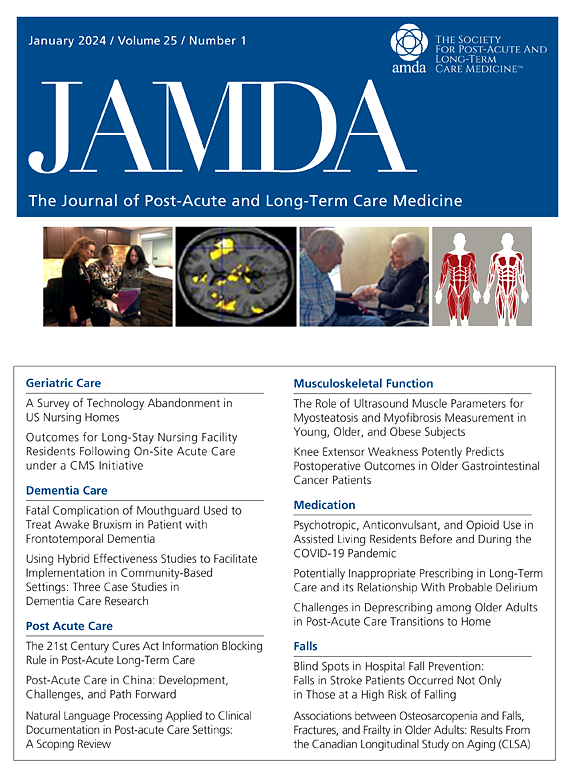Has Increased Medicaid Spending on Home- and Community-Based Services Reduced Unmet Needs in Activities of Daily Living Care among Community-Dwelling Older Adults with Dementia? Evidence from 2008 to 2020
IF 4.2
2区 医学
Q2 GERIATRICS & GERONTOLOGY
Journal of the American Medical Directors Association
Pub Date : 2025-06-10
DOI:10.1016/j.jamda.2025.105691
引用次数: 0
Abstract
Objectives
This study aimed to examine the potential impact of Medicaid total long-term services and supports (LTSS) expenditures and the proportion allocated to home- and community-based services (HCBS) on unmet needs among community-dwelling older adults with dementia.
Design
This is a retrospective study using nationally representative, longitudinal data and quasi-experimental approach.
Setting and Participants
A total of 2722 respondent-waves of community-dwelling older adults who participated in at least 1 of the 7 waves of Health and Retirement Study interviews between 2008 and 2020 and were identified as having dementia.
Methods
Unmet needs were assessed using a binary variable indicating whether respondents who reported difficulties with activities of daily living (ADL) did not receive the necessary assistance. Generalized linear models (GLMs) with a logit link function and binomial distribution, clustered at the individual level, were used for both bivariate and multivariable analyses. To address potential endogeneity, a 2-stage residual inclusion (2SRI) analysis was conducted using state education expenditures per pupil as an instrumental variable (IV). Additionally, the Durbin-Wu-Hausman (DWH) test was performed to assess endogeneity.
Results
Both GLM and IV regressions indicated that an increase in the share of HCBS relative to total Medicaid LTSS expenditures was associated with a significant reduction in unmet ADL needs among dementia individuals (ORGLM 0.77, 95% CIGLM 0.59-0.98, PGLM = 0.03; ORIV 0.76, 95% CIIV 0.58-1.00, PIV = 0.05). However, total Medicaid LTSS expenditures showed no significant association with patient unmet needs in either model. The DWH test for endogeneity supported the GLM estimates, confirming that total Medicaid LTSS expenditure was exogenous (P = .64). Sensitivity analyses excluding the total Medicaid LTSS expenditures yielded consistent estimates and suggested no collinearity between the independent variables.
Conclusions and Implications
A higher proportion of Medicaid LTSS expenditures allocated to HCBS can potentially reduce unmet needs for ADL among community-dwelling older adults with dementia, supporting efforts to shift long-term care from institutional to home- and community-based settings.
家庭和社区服务医疗补助支出的增加是否减少了居住在社区的老年痴呆症患者日常生活护理活动的未满足需求?证据从2008年到2020年。
目的:本研究旨在检查医疗补助总长期服务和支持(LTSS)支出以及分配给家庭和社区服务(HCBS)的比例对社区居住的老年痴呆症患者未满足需求的潜在影响。设计:这是一项回顾性研究,采用具有全国代表性的纵向数据和准实验方法。环境和参与者:在2008年至2020年期间,共有2722名社区居住的老年人参加了7次健康与退休研究访谈中的至少1次,并被确定患有痴呆症。方法:使用二元变量评估未满足的需求,表明报告日常生活活动困难(ADL)的受访者是否没有得到必要的帮助。具有logit链接函数和二项分布的广义线性模型(GLMs)在个体水平上聚类,用于双变量和多变量分析。为了解决潜在的内生性,我们进行了两阶段剩余纳入(2SRI)分析,使用每个学生的州教育支出作为工具变量(IV)。此外,采用Durbin-Wu-Hausman (DWH)检验来评估内生性。结果:GLM和IV回归均表明,HCBS相对于医疗补助LTSS总支出的份额的增加与痴呆个体未满足的ADL需求的显著减少相关(ORGLM 0.77, 95% CIGLM 0.59-0.98, PGLM = 0.03;Oriv 0.76, 95% civ 0.58-1.00, piv = 0.05)。然而,在两种模型中,医疗补助LTSS的总支出与患者未满足的需求没有显着关联。内生性的DWH检验支持GLM的估计,证实了医疗补助LTSS的总支出是外源性的(P = .64)。敏感度分析排除了总医疗补助LTSS支出得出一致的估计,并表明自变量之间没有共线性。结论和意义:较高比例的医疗补助LTSS支出分配给HCBS可以潜在地减少社区居住的老年痴呆症患者对ADL的未满足需求,支持将长期护理从机构转移到家庭和社区环境的努力。
本文章由计算机程序翻译,如有差异,请以英文原文为准。
求助全文
约1分钟内获得全文
求助全文
来源期刊
CiteScore
11.10
自引率
6.60%
发文量
472
审稿时长
44 days
期刊介绍:
JAMDA, the official journal of AMDA - The Society for Post-Acute and Long-Term Care Medicine, is a leading peer-reviewed publication that offers practical information and research geared towards healthcare professionals in the post-acute and long-term care fields. It is also a valuable resource for policy-makers, organizational leaders, educators, and advocates.
The journal provides essential information for various healthcare professionals such as medical directors, attending physicians, nurses, consultant pharmacists, geriatric psychiatrists, nurse practitioners, physician assistants, physical and occupational therapists, social workers, and others involved in providing, overseeing, and promoting quality

 求助内容:
求助内容: 应助结果提醒方式:
应助结果提醒方式:


